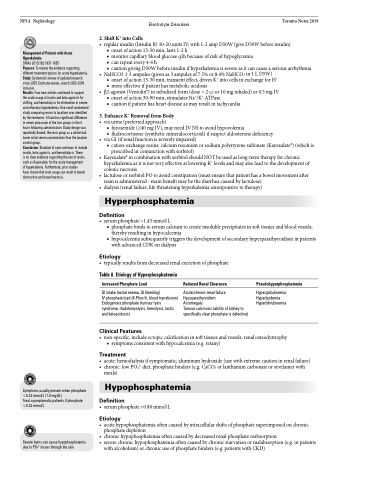Page 714 - TNFlipTest
P. 714
NP14 Nephrology
Electrolyte Disorders Toronto Notes 2019
2. Shift K+ into Cells
Management of Patients with Acute Hyperkalemia
CMAJ 2010;182:1631-1635
Purpose: To review the evidence supporting different treatment options for acute hyperkalemia. Study: Systematic review of updated research since 2005 Cochrane review, search 2003-2009 inclusive.
Results: Four new articles continued to support the acute usage of insulin and beta-agonists for shifting, and hemodialysis for elimination in severe and refractory hyperkalemia. One small randomized study comparing resins to laxatives was identified by the reviewers. It found no significant difference in serum potassium of the two groups in the 4 hours following administration. Study design was reportedly flawed; the resin group as a whole had lower initial serum concentration than the laxative control group.
Conclusion: Standard of care continues to include insulin, beta-agonists, and hemodialysis. There
is no clear evidence supporting the use of resins, such as Kayexalate, for the acute management
of hyperkalemia. Furthermore, prior studies have shown that resin usage can result in bowel obstruction and bowel necrosis.
•
• •
regularinsulin(InsulinR)10-20unitsIV,with1-2ampD50W(giveD50Wbeforeinsulin) ■ onset of action 15-30 min, lasts 1-2 h
■ monitor capillary blood glucose q1h because of risk of hypoglycemia
■ can repeat every 4-6 h
■ caution giving D50W before insulin if hyperkalemia is severe as it can cause a serious arrhythmia NaHCO3 1-3 ampules (given as 3 ampules of 7.5% or 8.4% NaHCO3 in 1 L D5W)
■ onset of action 15-30 min, transient effect, drives K+ into cells in exchange for H+
■ more effective if patient has metabolic acidosis
β2-agonist (Ventolin®) in nebulized form (dose = 2 cc or 10 mg inhaled) or 0.5 mg IV
■ onset of action 30-90 min, stimulates Na+/K+ ATPase
■ caution if patient has heart disease as may result in tachycardia
3. Enhance K+ Removal from Body
• via urine (preferred approach)
■ furosemide (≥40 mg IV), may need IV NS to avoid hypovolemia
■ fludrocortisone (synthetic mineralocorticoid) if suspect aldosterone deficiency
• viaGI(ifrenalfunctionisseverelyimpaired)
■ cation-exchange resins: calcium resonium or sodium polystyrene sulfonate (Kayexalate®) (which is
prescribed in conjunction with sorbitol)
• Kayexalate® in combination with sorbitol should NOT be used as long-term therapy for chronic
hyperkalemia as it is not very effective at lowering K+ levels and may also lead to the development of
colonic necrosis
• lactuloseorsorbitolPOtoavoidconstipation(mustensurethatpatienthasabowelmovementafter
resin is administered - main benefit may be the diarrhea caused by lactulose) • dialysis(renalfailure,lifethreateninghyperkalemiaunresponsivetotherapy)
Hyperphosphatemia
Definition
• serumphosphate>1.45mmol/L
■ phosphate binds to serum calcium to create insoluble precipitates in soft tissues and blood vessels,
thereby resulting in hypocalcemia
■ hypocalcemia subsequently triggers the development of secondary hyperparathyroidism in patients
with advanced CDK on dialysis
Etiology
• typicallyresultsfromdecreasedrenalexcretionofphosphate
Table 8. Etiology of Hyperphosphatemia
Increased Phosphate Load
GI intake (rectal enema, GI bleeding)
IV phosphate load (K-Phos®, blood transfusion) Endogenous phosphate (tumour lysis syndrome, rhabdomyolysis, hemolysis, lactic and ketoacidosis)
Clinical Features
Reduced Renal Clearance
Acute/chronic renal failure Hypoparathyroidism
Acromegaly
Tumour calcinosis (ability of kidney to specifically clear phosphate is defective)
Pseudohyperphosphatemia
Hyperglobulinemia Hyperlipidemia Hyperbilirubinemia
Symptoms usually present when phosphate <0.32 mmol/L (1.0 mg/dL)
Treat asymptomatic patients if phosphate <0.32 mmol/L
Severe burns can cause hypophosphatemia due to PO43- losses through the skin
• non-specific,includeectopiccalcificationinsofttissuesandvessels,renalosteodystrophy ■ symptoms consistent with hypocalcemia (e.g. tetany)
Treatment
• acute:hemodialysisifsymptomatic;aluminumhydroxide(usewithextremecautioninrenalfailure) • chronic: low PO43- diet, phosphate binders (e.g. CaCO3 or lanthanum carbonate or sevelamer with
meals)
Hypophosphatemia
Definition
• serumphosphate<0.80mmol/L
Etiology
• acutehypophosphatemiaoftencausedbyintracellularshiftsofphosphatesuperimposedonchronic phosphate depletion
• chronichypophosphatemiaoftencausedbydecreasedrenalphosphatereabsorption
• severe chronic hypophosphatemia often caused by chronic starvation or malabsorption (e.g. in patients
with alcoholism) or chronic use of phosphate binders (e.g. patients with CKD)


